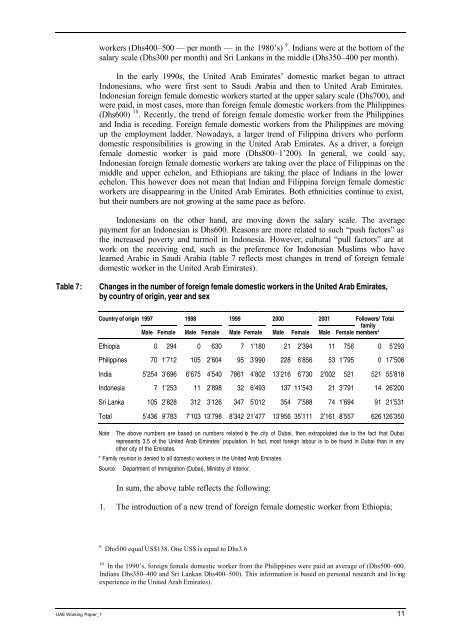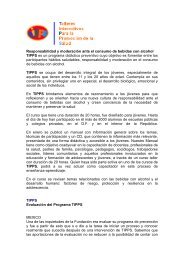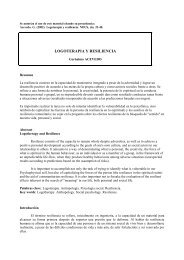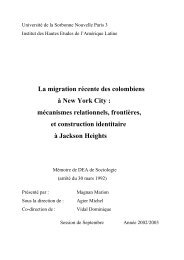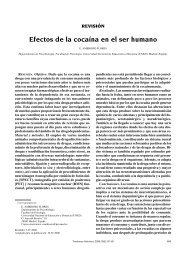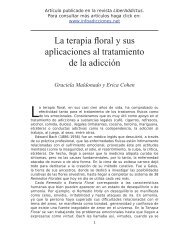migrant women in the United Arab Emirates
migrant women in the United Arab Emirates
migrant women in the United Arab Emirates
You also want an ePaper? Increase the reach of your titles
YUMPU automatically turns print PDFs into web optimized ePapers that Google loves.
workers (Dhs400–500 — per month — <strong>in</strong> <strong>the</strong> 1980’s) 9 . Indians were at <strong>the</strong> bottom of <strong>the</strong><br />
salary scale (Dhs300 per month) and Sri Lankans <strong>in</strong> <strong>the</strong> middle (Dhs350–400 per month).<br />
In <strong>the</strong> early 1990s, <strong>the</strong> <strong>United</strong> <strong>Arab</strong> <strong>Emirates</strong>’ domestic market began to attract<br />
Indonesians, who were first sent to Saudi <strong>Arab</strong>ia and <strong>the</strong>n to <strong>United</strong> <strong>Arab</strong> <strong>Emirates</strong>.<br />
Indonesian foreign female domestic workers started at <strong>the</strong> upper salary scale (Dhs700), and<br />
were paid, <strong>in</strong> most cases, more than foreign female domestic workers from <strong>the</strong> Philipp<strong>in</strong>es<br />
(Dhs600) 10 . Recently, <strong>the</strong> trend of foreign female domestic worker from <strong>the</strong> Philipp<strong>in</strong>es<br />
and India is reced<strong>in</strong>g. Foreign female domestic workers from <strong>the</strong> Philipp<strong>in</strong>es are mov<strong>in</strong>g<br />
up <strong>the</strong> employment ladder. Nowadays, a larger trend of Filipp<strong>in</strong>a drivers who perform<br />
domestic responsibilities is grow<strong>in</strong>g <strong>in</strong> <strong>the</strong> <strong>United</strong> <strong>Arab</strong> <strong>Emirates</strong>. As a driver, a foreign<br />
female domestic worker is paid more (Dhs800–1’200). In general, we could say,<br />
Indonesian foreign female domestic workers are tak<strong>in</strong>g over <strong>the</strong> place of Filipp<strong>in</strong>as on <strong>the</strong><br />
middle and upper echelon, and Ethiopians are tak<strong>in</strong>g <strong>the</strong> place of Indians <strong>in</strong> <strong>the</strong> lower<br />
echelon. This however does not mean that Indian and Filipp<strong>in</strong>a foreign female domestic<br />
workers are disappear<strong>in</strong>g <strong>in</strong> <strong>the</strong> <strong>United</strong> <strong>Arab</strong> <strong>Emirates</strong>. Both ethnicities cont<strong>in</strong>ue to exist,<br />
but <strong>the</strong>ir numbers are not grow<strong>in</strong>g at <strong>the</strong> same pace as before.<br />
Indonesians on <strong>the</strong> o<strong>the</strong>r hand, are mov<strong>in</strong>g down <strong>the</strong> salary scale. The average<br />
payment for an Indonesian is Dhs600. Reasons are more related to such “push factors” as<br />
<strong>the</strong> <strong>in</strong>creased poverty and turmoil <strong>in</strong> Indonesia. However, cultural “pull factors” are at<br />
work on <strong>the</strong> receiv<strong>in</strong>g end, such as <strong>the</strong> preference for Indonesian Muslims who have<br />
learned <strong>Arab</strong>ic <strong>in</strong> Saudi <strong>Arab</strong>ia (table 7 reflects most changes <strong>in</strong> trend of foreign female<br />
domestic worker <strong>in</strong> <strong>the</strong> <strong>United</strong> <strong>Arab</strong> <strong>Emirates</strong>).<br />
Table 7:<br />
Changes <strong>in</strong> <strong>the</strong> number of foreign female domestic workers <strong>in</strong> <strong>the</strong> <strong>United</strong> <strong>Arab</strong> <strong>Emirates</strong>,<br />
by country of orig<strong>in</strong>, year and sex<br />
Country of orig<strong>in</strong> 1997 1998 1999 2000 2001<br />
Followers/ Total<br />
family<br />
Male Female Male Female Male Female Male Female Male Female members*<br />
Ethiopia 0 294 0 630 7 1’180 21 2’394 11 756 0 5’293<br />
Philipp<strong>in</strong>es 70 1’712 105 2’604 95 3’990 228 6’856 53 1’795 0 17’508<br />
India 5’254 3’696 6’675 4’540 7861 4’802 13’216 6’730 2’002 521 521 55’818<br />
Indonesia 7 1’253 11 2’898 32 6’493 137 11’543 21 3’791 14 26’200<br />
Sri Lanka 105 2’828 312 3’126 347 5’012 354 7’588 74 1’694 91 21’531<br />
Total 5’436 9’783 7’103 13’798 8’342 21’477 13’956 35’111 2’161 8’557 626 126’350<br />
Note: The above numbers are based on numbers related to <strong>the</strong> city of Dubai, <strong>the</strong>n extrapolated due to <strong>the</strong> fact that Dubai<br />
represents 3.5 of <strong>the</strong> <strong>United</strong> <strong>Arab</strong> <strong>Emirates</strong>’ population. In fact, most foreign labour is to be found <strong>in</strong> Dubai than <strong>in</strong> any<br />
o<strong>the</strong>r city of <strong>the</strong> <strong>Emirates</strong>.<br />
* Family reunion is denied to all domestic workers <strong>in</strong> <strong>the</strong> <strong>United</strong> <strong>Arab</strong> <strong>Emirates</strong>.<br />
Source: Department of Immigration (Dubai), M<strong>in</strong>istry of Interior.<br />
In sum, <strong>the</strong> above table reflects <strong>the</strong> follow<strong>in</strong>g:<br />
1. The <strong>in</strong>troduction of a new trend of foreign female domestic worker from Ethiopia;<br />
9 Dhs500 equal US$138. One US$ is equal to Dhs3.6<br />
10 In <strong>the</strong> 1990’s, foreign female domestic worker from <strong>the</strong> Philipp<strong>in</strong>es were paid an average of (Dhs500–600,<br />
Indians Dhs350–400 and Sri Lankan Dhs400–500). This <strong>in</strong>formation is based on personal research and liv<strong>in</strong>g<br />
experience <strong>in</strong> <strong>the</strong> <strong>United</strong> <strong>Arab</strong> <strong>Emirates</strong>).<br />
UAE Work<strong>in</strong>g Paper_1 11


